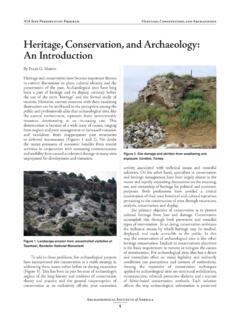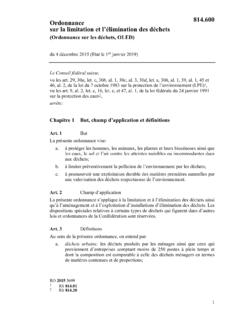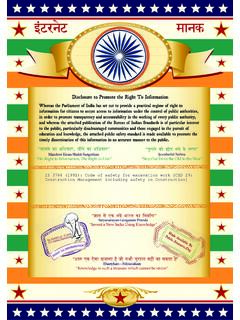Transcription of Archaeology 101 Material culture Introduction that ...
1 Archaeology 101 IntroductionArchaeology is the study of past cultures through the Material (physical) remains people left behind. These can range from small artifacts, such as arrowheads, to large buildings, such as pyramids. Anything that people created or modified is part of the archaeological use these remains to understand and re-cre-ate all aspects of past culture , from the daily lives of ordinary people to the grand conquests of emperors. Often, these objects are buried and have to be carefully uncovered or excavated before they can be studied. In many cases, they are the only clues archaeologists have to help them reconstruct the lives of ancient people.
2 These objects are like pieces of a giant jigsaw puzzle that the archaeologist must excavation of Iron Age pots at Tongobriga, PortugalArchaeology helps us to appreciate and preserve our shared human heritage. It informs us about the past, helps us understand where we came from, and shows us how people lived, overcame challenges, and developed the societies we have today. The focus of Archaeology has changed over the years. Archae-ologists today study everything from ancient pots to DNA to theories of cognitive processes. This expanded scope of Archaeology has necessitated the creation of many new interpretive approaches and recovery techniques.
3 While the trowel continues to be a primary tool, archaeologists have also added satellite imagery, computers, and robotics to their arsenal. Excavations now often include dozens of experts from varied disciplines, including ceramics, osteology, geol-ogy, and botany, as well as research technicians with highly specialized cultureWhen we talk about culture , we mean the behavior and beliefs of groups of people. These cannot be excavated directly, although they influence the physical remains, Material culture , that archaeologists find. These remains range from stone tools to buildings to written records.
4 Features are remains that can-not be moved (large buildings, post holes), while artifacts are smaller, portable preservation of Material culture depends on the type of materials (organic, which decay more quickly, or inorganic) and the environmental conditions to which they have been exposed. Materials deposited in the open are affected by factors such as rain, sun, snow, wind, and other natural phenomena. Buried materials are usually better preserved than those exposed to the environment. Dry conditions generally preserve remains better than wet, although the airlessness of bogs and other underwater conditions can also preserve many objects.
5 In rare circumstances freezing, in mountaintop glaciers or tundra, can also preserve sites, artifacts, and even human of archaeologyThere are many branches of Archaeology , some of which over-lap. Prehistoric archaeologists deal with time periods before the invention of writing. Historical archaeologists have the luxury of examining both physical remains and texts (when they survive). Industrial archaeologists study buildings and remains that date to the period after the Industrial Revolu-tion. Archaeologists generally choose to focus on a particular culture that often is associated with a chronological period: classical Archaeology covers the civilizations affected by the Greeks and Romans, Egyptian Archaeology deals with Egypt, Mesoamerican Archaeology focuses on cultures in Central America and Mexico, and so on.
6 An excavator brushes sand away from an elephant bone at Hierakonpolis, EgyptArchaeological Institute of America1 AIA Education Department Lesson PlansJason UrbanusHierakonpolis ExpeditionArchaeologists help reconstruct the past in other ways besides simply excavating sites belonging to a particular culture . Eth-noarchaeologists study people living today and record how they organize and use objects. The study of modern behavior can help reveal how and why people in the past left behind certain types of remains in certain patterns. Environmental archaeologists help us understand the conditions that existed when the people being studied were alive.
7 Experimental archaeologists reconstruct techniques and processes used in the past to create artifacts, art, and architecture. Underwater archaeologists study Material remains that survive underwa-ter, including shipwrecks and sites inundated by a rise in sea level. Others, working in the field of cultural resource man-agement, assess archaeological remains at construction sites in order to record critical information and preserve as much as possible before the site is destroyed or covered fragmentary amphora or storage jar recovered from a thirteenth-century shipwreckThe process of archaeologyArchaeology uses scientific principles to guide its practices.
8 Before beginning to excavate, an archaeologist needs a reason to dig, an excavation plan, and permission from the government of the place being excavated. Although Archaeology is usually associated with digging, sometimes the goal is not to excavate, but rather to identify and plot sites across a landscape or region to see the big picture of habitation or activity in an are some of the steps of an archaeological project:Hypothesis creation Archaeologists do not dig randomly in search of artifacts. Excavations are conducted to answer specific questions or resolve particular issues.
9 The only exception is in cultural resource management, undertaken when sites are in danger of being and site locationOnce archaeologists have a reason to dig, they must identify where to dig. Sometimes, unexpectedly discovering evidence that a site existed in an area is the impetus to dig but even then the goal is not just to dig the site, but to answer questions about the people in their environment. Evidence for sites can take many forms, including information provided in myths and stories, historical references, old maps, farmers reports of finds in their fields, satellite photographs showing patterns not visible from the ground, and the results of subsurface detection methods such as ground-penetrating radar.
10 Traditional surface survey often involves hours of walking over miles of terrain to find sites. Sites identified during survey (usually by patterns of small finds, such as broken pieces of pottery) are plotted on a map. Once an excavation site has been located, a detailed map is also made before digging begins. The map is the first of a series of records made during an archaeological This is the most well known aspect of Archaeology . Archaeol-ogists excavate remains buried under the earth. Soil and other deposits build up naturally above sites over time through slow accumulation and more dramatic climatic events.








